Strength in numbers Please share
advertisement
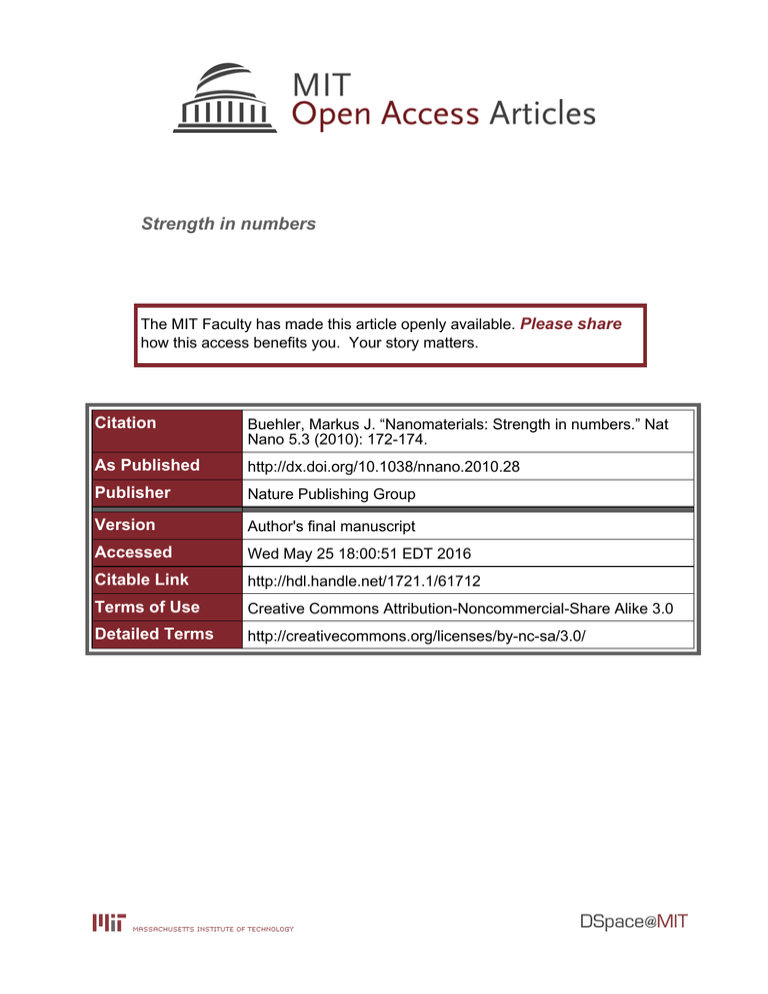
Strength in numbers The MIT Faculty has made this article openly available. Please share how this access benefits you. Your story matters. Citation Buehler, Markus J. “Nanomaterials: Strength in numbers.” Nat Nano 5.3 (2010): 172-174. As Published http://dx.doi.org/10.1038/nnano.2010.28 Publisher Nature Publishing Group Version Author's final manuscript Accessed Wed May 25 18:00:51 EDT 2016 Citable Link http://hdl.handle.net/1721.1/61712 Terms of Use Creative Commons Attribution-Noncommercial-Share Alike 3.0 Detailed Terms http://creativecommons.org/licenses/by-nc-sa/3.0/ 1 M.J. Buehler, “Strength in numbers”, Nature Nanotechnology , Vol. 5, pp. 172-174, 2010 NANOMATERIALS Strength in numbers Self-assembly of proteins commonly associated with neurodegenerative diseases can be exploited to make well-ordered and strong functional macroscopic materials. Markus J. Buehler1 Biological materials are able to perform many different functions – such as providing structural support, generating forces, acting as catalytic or converting energy from one form to another1,2 – because they have hierarchical structures that are composed of amino acids, alpha-helices or beta-sheets. Researchers have built nanostructures that are as complex as those found in biology, but turning these nanostructures into useful macroscopic materials remains a challenge because it is difficult to achieve the same level of control at all the different length scales involved. Writing in Nature Nanotechnology, Mark Welland and colleagues3 at Cambridge University report a novel approach to making multifunctional hierarchical biomaterials by exploiting the self-assembling properties of amyloid fibrils, which are associated with severe neurodegenerative diseases such as Alzheimer’s and Parkinson’s4, but are also found to be natural adhesives5. The protein fibrils that were cast into thin films aligned and stacked in the 2 plane of the film to form a strong material (with both nano- and micro-metre scale order) that could interact with visible light. Although only a limited number of universal protein building blocks are found in Nature, the key to achieving diversity is to create order at several length scales (Fig. 1a). Because each level in the hierarchy is associated with a specific property and essentially compartmentalized at that scale, biological materials can integrate multiple and disparate properties in a single material. Through self-assembly, materials with a broad range of properties can be realized by simply reorganizing the fundamental protein constituents to create different levels of order and disorder. This circumvents the need to introduce new building blocks for new properties. Although the properties of nanomaterials are often superior to those of conventional materials, translating these advantages to macroscopic scales remains a challenge. For instance, carbon nanotubes or graphene are among the strongest materials known, but they are not widely used in structural materials because we have yet to learn how to connect the disparate scales while maintaining their superior qualities found at the nanoscale. Amyloids -- a class of protein materials with an innate capacity to self-assemble into hierarchical structures (Fig. 1a) -- can form from diverse protein sequences6 through a process called amyloidogenesis. In the process, the proteins lose their native functional configuration (for example, as enzymes or hormones) and form fibres with a typical hydrogen-bonded cross-betasheet structure (Fig. 1b). These characteristic features are universal to all amyloids and have been linked to their high stability, stiffness and capacity to provide structural templates across length-scales7-9. Variations in the protein sequence give rise to biochemical properties specific to particular amyloids. Deleted: 3 Welland and colleagues used amyloid proteins to create multifunctional macroscopic materials by carefully organizing the few protein constituents to achieve the necessary diversity at each level of the hierarchy (Fig. 1b). The amyloid protein molecules are first assembled into fibrils, which are then cast onto a flat polytetrafluoroethylene thin film. The resulting material contains fibrils that are well-stacked and -ordered at the nano- and micro-metre scale. Due to the order, the films blocked the transmission of light when the polarizer was parallel to the alignment of the fibrils, and transmitted light when the angle between the polarizer and the fibrils was 45º. At a fundamental level, the protein sequence can be altered to design the biochemical properties of amyloids. Similarly, Welland and co-workers found that molecules that would not naturally form hierarchical structures, such as fluorophores, could be organized into specific patterns when they were chemically attached to the amyloid fibrils. At larger hierarchical levels, addition of plasticising molecules controls the arrangement of amyloid fibrils in the material, which in turn, controls the mechanical and optical properties of the material. These structural alterations make it possible to create materials with a diverse range of functional properties based on a limited set of universal elements. The high level of organization at multiple length scales is critical in providing exceptional functionality at the macroscale. An intriguing aspect of this work is that the material reaches a mechanical stiffness comparable to carbon-based nanomaterials. This is notable because the fundamental chemical interactions in amyloids are weak hydrogen-bonds, but by simply arranging them into nanometre size clusters like those in the universal beta-strand motif (Fig. 1b)10 the intrinsic weakness of hydrogen-bonds is overcome. In this arrangement, hydrogenbonds work cooperatively and reach shear strengths of hundreds of mega Pascal, approaching the mechanical performance of steel. 4 Using hydrogen-bonds in beta-sheet structures under nanoconfinement shows how a weakness can be turned into a strength. Most engineered materials rely on strong bonding (for example, covalent) that typically requires a significant amount of energy during the synthesis, and once these bonds are broken catastrophic failure of the material occurs. In contrast, materials made using weak hydrogen-bonding systems can be self-assembled at moderate temperatures and are self-healing because broken bonds can be easily reformed into a fully functional state. The behaviour of the new amyloid-based material under extreme mechanical conditions, such as large deformation and failure, could be explored in future studies, leading perhaps to a new material platform for extremely stretchy, tough and strong biomaterials. Furthermore, the potential to enhance these materials beyond using naturally occurring building blocks such as beta-sheets exists; for example, it might be possible to combine amyloids with carbon nanotubes to form yet stronger materials. Of future interest is to implement the ability to switch the structure of the material at different levels of the hierarchy using external signals such as temperature, pH, magnetic or electric fields. Such mechanomutable materials may be used as tiny valves, sensors and actuators, or even as platforms for spatially and temporally controlling the growth of cells. Moreover, by tuning the failure properties of a material, it may be possible to develop novel armour materials that can mitigate different types of impact loading. The possibilities are unlimited. Markus J. Buehler is at the 1Laboratory for Atomistic and Molecular Mechanics, Department of Civil and Environmental Engineering, 2Center for Materials Science and Engineering, 3Center for Computational Engineering, Massachusetts Institute of Technology, 77 Massachusetts Ave., Cambridge, MA 02139, USA. e-mail: mbuehler@MIT.EDU 5 REFERENCES 1. Lakes, R. Nature 361, 511-515 (1993). 2. Buehler, M. J. & Yung, Y. C. Nat. Mater. 8, 175-188 (2009). 3. Knowles, T. P. J., Oppenheim, T., Buell, A. K., Chirgadze, D. Y. & Welland, M. E. Nature Nanotech. doi: XXXX (2010). 4. Chiti, F. & Dobson, C. M. Annu. Rev. Biochem. 75, 333-366 (2006). 5. Mostaert, A. S. et al. J. Adhesion 85, 465-483 (2009). 6. Kayed, R. et al. Science 300, 486-489 (2003). 7. Knowles, T. P. et al. Science 318, 1900-1903 (2007). 8. Cherny, I. & Gazit, E. Angew. Chem. Intl. Ed. 47, 4062-4069 (2008). 9. Hamley, I. W. Angew. Chem. Intl. Ed. 46, 8128-8147 (2007). 10. Keten, S. & Buehler, M.J. Nano Lett. 8, 743-748 (2008). 6 Figure 1 | Combining universal building blocks creates well-ordered biological nanomaterials with superior properties. a, Hierarchical structure of amyloid protein materials. Hydrogen-bonds (H1) with characteristic lengths on the order of a fraction of a nanometre provide the chemical bonding that forms beta-strands (H2), which in turn, form highly ordered, twisted fibrils (H3). The fibrils grow into long fibres (H4) that are then arranged into plaques, or films through a casting process (H5). b, Amyloid fibrils are formed through the assembly of a diverse set of native proteins, which lose their functional configuration and transform into a universal beta-sheet rich state. The assembly of amyloid fibrils into different geometries creates a diverse range of materials with tunable mechanical and optical properties.

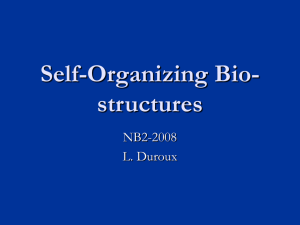
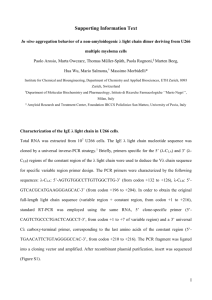
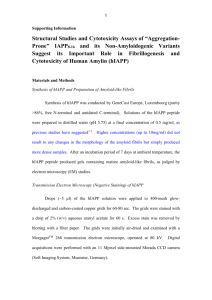
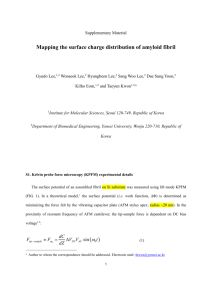


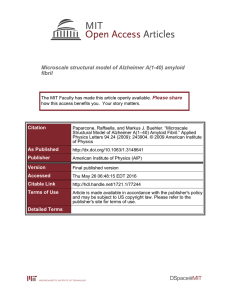
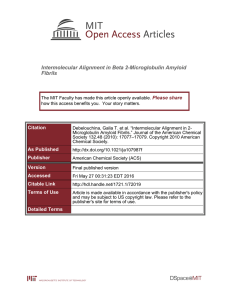
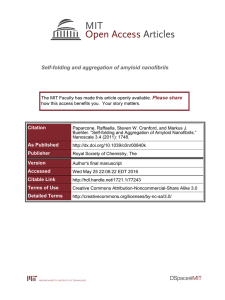
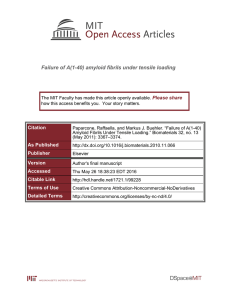
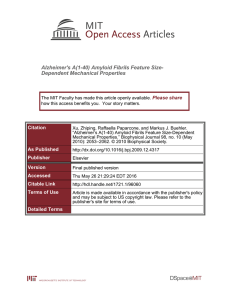
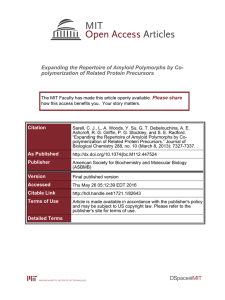
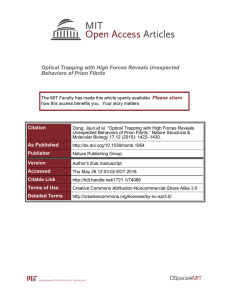
![Magic Angle Spinning NMR Analysis of [subscript 2]- Morphologies](http://s2.studylib.net/store/data/012639283_1-3df9bc70ba2c11cf52ace371397c5d1f-300x300.png)